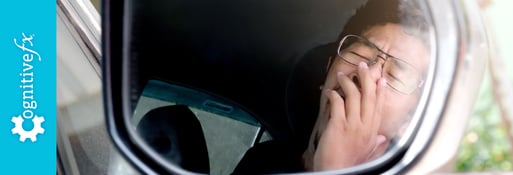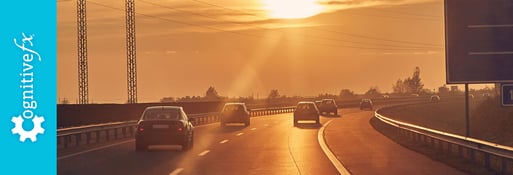To Sleep or to Drive? – Driving Drowsy Prevention Week 2017
Drowsy driving prevention focuses on "Stay alert, arrive alive." The national sleep foundation is helping to raise awareness of drowsy driving and the risks of driving when you are tired.
Published peer-reviewed research shows that Cognitive FX treatment leads to meaningful symptom reduction in post-concussion symptoms for 77% of study participants. Cognitive FX is the only PCS clinic with third-party validated treatment outcomes.
READ FULL STUDY

When it comes to multitasking, we all think we’re great at it, but really only about 2% of people can successfully multitask, according to Psychology Today. Even if you think you MIGHT be one of these people, chances are, you’re probably not. Yet it seems that we all like to test out that theory in inappropriate places, specifically when we’re on the road.
Most of us have sent a text or talked on the phone while driving, but we also all have been in or know someone who has been in an accident involving distracted driving. You’d think we would have gotten the hint by now, especially with driving laws being the way that they are. According to the Governors Highway Safety Association, “ 15 states prohibit all drivers from using hand-held cellphones while driving”, and “all states except 2 include at least one category for distraction on police crash report forms.”
it’s clear that it’s an epidemic; people are aware that it’s happening, but we’re still doing it. Why is that, when a split second spent looking at your phone could end up harming or even killing someone? According to the CDC, 9 people are killed and over 1,000 are injured EVERY DAY from distracted driving. That’s too many. Take a look at some of these other recent distracted driving statistics.
In March of 2010, AT&T launched the “It Can Wait” campaign to bring awareness to the issue, and to encourage people to put down their phones while driving. You can take the pledge yourself today at https://www.itcanwait.com/pledge. They also encourage the downloading of their free “DRIVEMODE” app, which minimizes phone distractions while you’re driving. Keep yourself safe, and keep others safe on the road.
"Driver Electronic Device Use in 2010." Traffic Safety Facts: National Highway Traffic Safety Administration. December 2011.
"State lawmakers try to curb driver distractions." Pittsburgh Post-Gazette. October 2007.
"Teen texting is OTT, even at wheel." Pittsburgh Post-Gazette. July 2007.
"Bill would require motorists to unhand their phones." Pittsburgh Post-Gazette. June 2006.
"PennDOT Teen Driver Safety Week News Release." Pennsylvania Department of Transportation. October 22, 2008.
"Cellphones and Driving." Insurance Information Institute. October 2008.
"AMA acts against trans fats, texting while driving." Washington Post. November 10, 2008.
"Teen Texting is OTT, Even at Wheel." Pittsburgh Post-Gazette. July 17, 2007.
"Distractions Challenge Teen Drivers." USA Today. January 26, 2007.
"Distracted Driving 2009." National Highway Traffic Safety Administration. September 2010.
"Driver Electronic Use in 2009." National Highway Traffic Safety Administration. September 2010.
"Distracted Driving and Driver, Roadway, and Environmental Factors." National Highway Traffic Safety Administration. September 2010.
"Most U.S. Drivers Engage in 'Distracted' Driving Behaviors." USAToday.com. December 1, 2011.
"2012 Distracted Driving Attitudes and Behaviors Survey." NHTSA.
"2011 National Occupant Protection Use Survey on Driver Electronics Use." NHTSA.
"2011 Morbidity and Mortality Weekly Report." Centers for Disease Control and Prevention.
"2011 Youth Risk Behavior Surveillance System." Centers for Disease Control and Prevention.
"Distracted Driving 2011." National Highway Traffic Safety Administration.
"Distracted Driving – What Research Shows and What States Can Do." Governors Highway Safety Association. 2011.
National Safety Council.
"New Pennsylvania law not yet putting a dent in texting while driving." Pittsburgh Post-Gazette. April 11, 2013.
“What is Distracted Driving? Key Facts and Statistics” NHTSA National Highway Traffic Safety Administration.
Schroeder, P., Meyers, M., & Kostuniuk, L. (2013, April). National survey on distracted driving attitudes and behaviors – 2012. (Report No. DOT HS 811 729). Washington, DC: National Highway Traffic Safety Administration. "Distracted Driving 2013." National Highway Traffic Safety

The "Cognitive FX Team" is a collaborative ensemble of distinguished doctors, therapists, and practitioners. Our experts are pioneers in the field of neuroimaging and concussion treatment. With extensive experience and a strong commitment to patient care, our team excels in utilizing cutting-edge technologies, such as functional MRI (fMRI), to provide personalized diagnostic and treatment strategies. Our renowned professionals have published groundbreaking research, developed innovative neuroimaging biomarkers, and conducted thousands of individualized patient assessments. We take pride in our holistic approach to patient care, focusing on physical, cognitive, and emotional aspects of recovery. As leaders in the industry, the Cognitive FX Team is dedicated to advancing the science of concussion diagnosis and treatment to provide our patients with the highest level of care and support.

Drowsy driving prevention focuses on "Stay alert, arrive alive." The national sleep foundation is helping to raise awareness of drowsy driving and the risks of driving when you are tired.

According to the CDC, “there are around 2.8 million TBI (Traumatic Brain Injury)-related emergency department visits, hospitalizations, and deaths each year in the United States. TBI contributed to...

It is that time of year, time to set back your clocks by an hour. The end of daylight savings time is a time of year that many people look forward to for that extra hour of sleep. This one-hour...

Did you know that concussions are among of the top injuries sustained while skiing and snowboarding? Beginners and professionals alike need to be equipped with the tools to stay safe on the slopes.

Helmets are worn in countless sports and activities to protect the head from injury, specifically brain injury. We all wear helmets frequently in our lives, whether it is for something as as simple...

Past patient, Anna Empey shares her experiences in a series of blog posts including "10 Things I Wish I had known Before my Brain Injury", "Journaling Through...
Published peer-reviewed research shows that Cognitive FX treatment leads to meaningful symptom reduction in post-concussion symptoms for 77% of study participants. Cognitive FX is the only PCS clinic with third-party validated treatment outcomes.
READ FULL STUDY